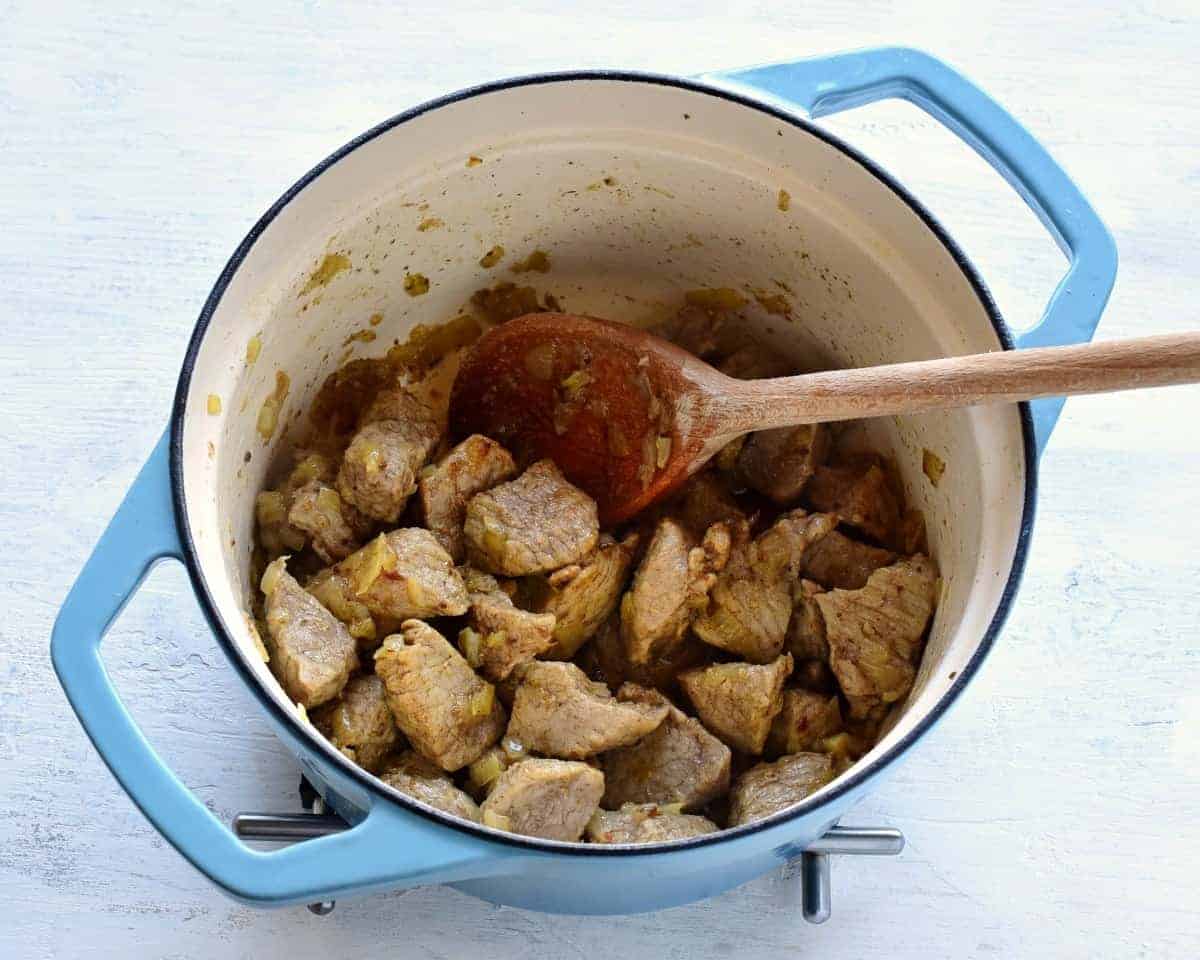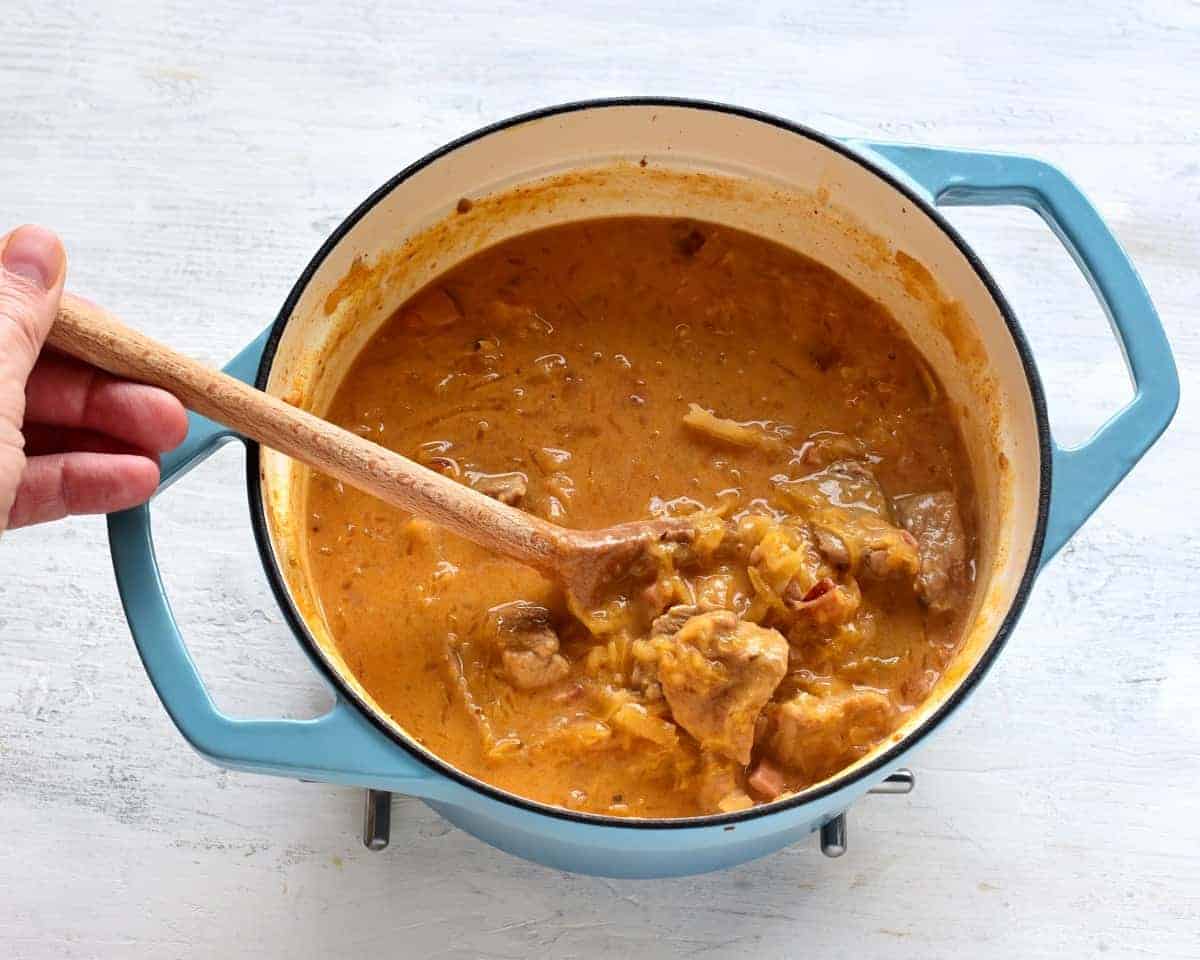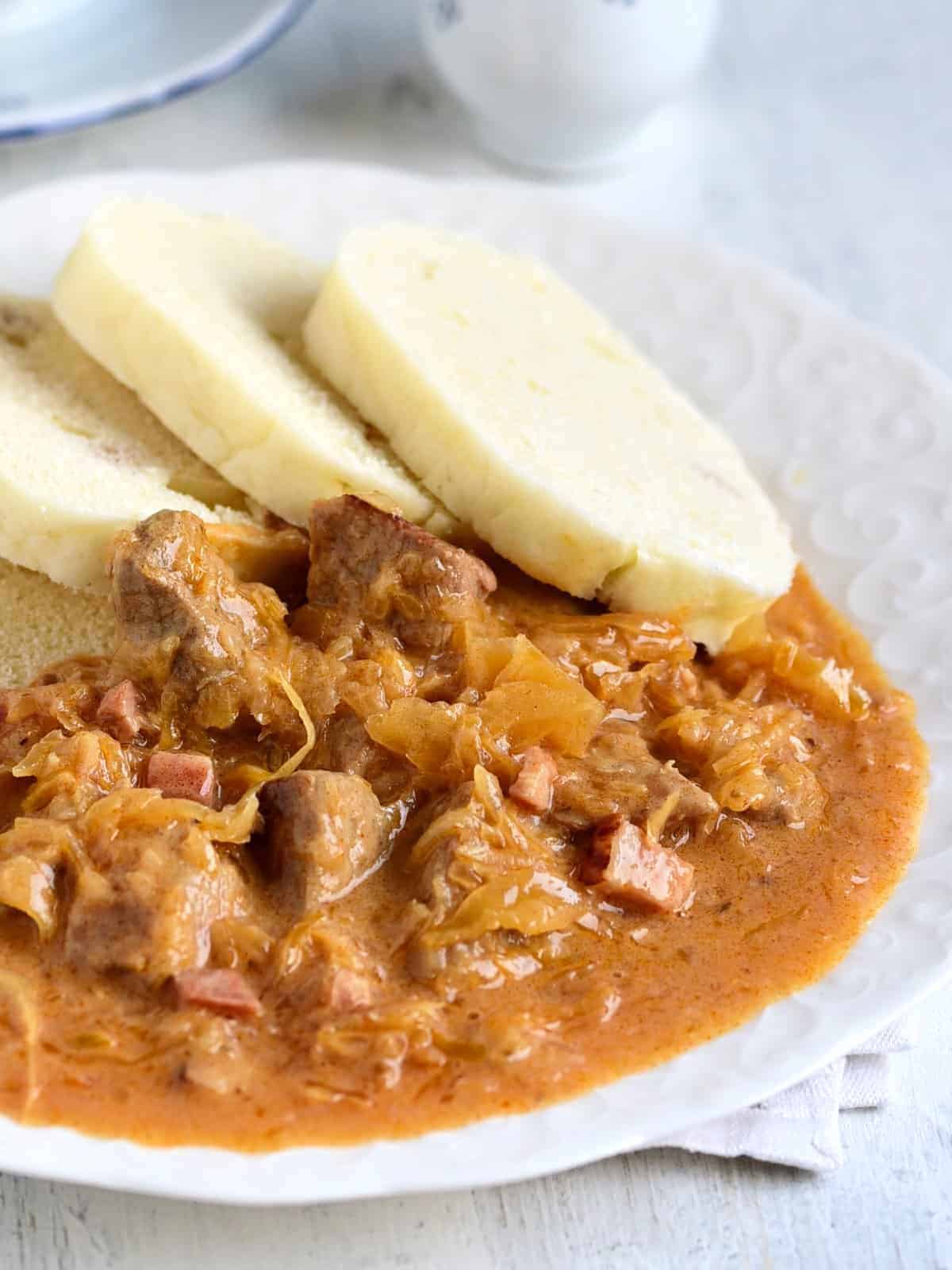Soft pork chunks with tangy sauerkraut gravy, so flavorful and comforting! I’m talking about segedínský guláš, one of the traditional Hungarian goulashes, which is also very popular in Czech cuisine.

➜ What Is Segedínský guláš
Segedínský guláš, in English Szegedin or Szegediner Goulash, according to a Czechoslovakian recipe, is a pork stew slowly simmered with sauerkraut. The dish is spiced with sweet ground paprika, caraway seeds and smoothed by adding sour cream at the end of cooking.
This sauerkraut goulash originated in Hungary, specifically from the city Szeged, called Segedín in the Czech language. Szeged leaned its name to this zesty goodness, we call it segedínský guláš or shortly segedín here in the Czech Republic.
Segedín is usually served with raised Czech bread dumplings.
Hungarians know szegedin goulas as Székely Gulyás. If you want to try the classic version, check out the recipe for this slow cooker Hungarian goulash.
Another traditional Hungarian dish worth trying is chicken paprikash.
MY TIP: Talking about sauerkraut, don’t miss zelňačka, delicious Czech-style cabbage soup!
➜ Ingredients

Let’s take a look at the shopping list:
- Pork shoulder; it’s the best cut of pork for segedín, well-marbled and succulent enough for a perfect achievement
- Bacon; diced into ¼-inch pieces
- Onions; peeled and finely chopped
- Sauerkraut; squeeze the juice out of the sauerkraut. Try to get German sauerkraut in your local store. I’ve heard that German sauerkraut sold in the USA resembles the kind sold in the Czech Republic.
- Clove of garlic; peeled and pressed or crushed
- Pork lard; in Czech sádlo, to sauté onion and pork, use vegetable oil optionally
- Caraway seed; crushed (learn, how to grind spices by hand)
- Sweet paprika ground; the original sweet Hungarian paprika works pretty fine, however, it’s not necessary, any good sweet paprika will do a good job
- All-purpose flour; to thicken the goulash
- Sour cream; an essential ingredient, will add a sweet flavor and make the segedín smooth. Please don’t use any light sour cream; it should contain about 15 % fat.
- Salt
- Water; or beef stock for more flavor (it’s not displayed in the photo with ingredients)
✅ You’ll find the exact amount of ingredients below in the recipe card, which you can also print out.
➜ Instructions
Before you start cooking: Cut the pork into 1-inch pieces. Peel onions and chop them finely. Peel a clove of garlic and press it. Cut bacon into small ¼-inch dices. Strain the sauerkraut (do not rinse it!) and cut it into bite-size pieces.
STEP 1: In a pot with a thick bottom (I use one of my beloved dutch ovens), melt half of the lard over medium heat. Add diced bacon and render; it takes about 3-5 minutes. Stir occasionally. Set the rendered bacon aside, use a slotted spoon.

STEP 2: Place the rest of the lard in the same pot, sprinkle with crushed caraway seeds. Stir. Add chopped onions and sauté them until slightly golden.


STEP 3: Turn the heat up, add pork and sear the meat for 3 minutes, stirring frequently.

STEP 4: Reduce heat to medium, dust with sweet ground paprika. Add pressed garlic. Fry for 1 minute while stirring.

Add flour and fry for a further 1 minute. Stir well.

STEP 5: Salt the base for segedín, pour in the water or beef broth that the pork is covered. Bring to a boil. Reduce the heat to a minimum, cover with a lid and let it simmer for 30 minutes.

STEP 6: Only now add fried bacon, sauerkraut, and let it cook for additional 30 minutes, or until the pork is tender. Stir occasionally.

STEP 7: As the final step, add sour cream, don’t cook anymore.

Just stir well, salt to your liking, and Szegedin goulash is done!

➜ Serving
Serve segedínský guláš warm, it pairs perfectly with bread dumplings. You can use boiled potatoes or a slice of fresh rye bread as an alternative to them, however.

➜ Cook’s Tips
- The authentic Szegedin goulash is made with pork, not with beef. Pork shoulder is the best meat cut for a succulent result. If you want beef goulash, try this Czech tried and true recipe: Hovězí guláš
- Add the sauerkraut into the goulash in the last 30 minutes of cooking. If you added it earlier, sauerkraut would be overcooked.
- As with other goulash dishes, segedínský guláš tastes better the day after you made it.
More Czech sauces:
- Rajská omáčka – sweet tomato gravy
- Svíčková na smetaně – famous Czech sauce made with root vegetables and heavy cream
- Knedlo vepřo zelo – pork roast and sauerkraut
TIP: Browse Czech cherished recipes category for more ideas!
Tried this recipe?
Leave a review down in the comments! ⭐⭐⭐⭐⭐
Follow me on Facebook and Pinterest. Subscribe to my newsletter. Send me any question about Czech cuisine to my e-mail. I love hearing your feedback!

Segedínský guláš – Czech Szegedin Goulash
Ingredients
- 1 and ½ pounds pork shoulder (680 g)
- 4 ounces bacon (110 g)
- 3 onions mid-sized
- 10 ounces Sauerkraut (280 g)
- 1 clove garlic
- 1 Tablespoon pork lard
- 1 teaspoon caraway seeds crushed
- 1 Tablespoon sweet ground paprika
- 1 Tablespoon all-purpose flour heaped
- 3 cups beef broth (720 ml) or water
- ¾ cup sour cream (180 g)
- 1 teaspoon salt
Instructions
- Before you start cooking: Cut the pork into 1-inch pieces. Peel onions and chop them finely. Peel a clove of garlic and press it. Cut bacon into small ¼-inch dices. Strain the sauerkraut (do not rinse it!) and cut it into bite-size pieces.
- In a pot with a thick bottom (I use one of my beloved dutch ovens), melt half of the lard over medium heat. Add diced bacon and render; it takes about 3-5 minutes. Stir occasionally. Set the rendered bacon aside, use a slotted spoon.
- Place the rest of the lard in the same pot, sprinkle with crushed caraway seeds. Stir. Add chopped onions and sauté them until slightly golden while stirring.
- Turn up the heat, add pork and sear the meat for 3 minutes, stirring frequently.
- Reduce heat to medium, dust with sweet ground paprika. Add pressed garlic. Fry for 1 minute while stirring.
- Add flour and fry for a further 1 minute. Stir well.
- Salt the base for segedín, pour in the water or beef broth that the pork is covered. Bring to a boil. Reduce the heat to a minimum, cover with a lid and let it simmer for 30 minutes.
- Only now add fried bacon, sauerkraut, and let it cook for additional 30 minutes, or until the pork is tender. Stir occasionally.
- As the final step, add sour cream, don’t cook anymore.
- Just stir well, salt to your liking, and Szegedin goulash is done!
Notes
- Makes 4 portions.
- The amount of salt added to segedínský guláš depends on the taste of sauerkraut; Czech sauerkraut is salt enough, that’s why there is only 1 tsp of salt in the recipe.
- Serve with bread dumplings.
- The authentic Szeged goulash is made with pork, not with beef. Pork shoulder is the best meat cut for a succulent result.
- Add the sauerkraut into the goulash in the last 30 minutes of cooking. If you added it earlier, sauerkraut would be overcooked.
- As with other goulash dishes, segedínský guláš tastes better the other day.
DISCLAIMER: Because I come from Central Europe, my recipes are based on metric units such as grams or milliliters. Check out how I convert metric units to the U.S. system:
Conversion chart





Jan
One of my favorite's
Petra Kupská
Mine too. The advantage is that Szegediner is made from pork, so it is much faster on the table than a beef goulash.
Ted
Good recipe, excellent dish. Just FYI it did not originate in Szeged, and strictly speaking it's not even a gulash. The Hungarian name is szekelygulyas or szekelykaposzta, 'szekely' referring to a region in today's Rumania. But the dish apparently originated in Budapest, and it is named after a man called Szekely. (G.Lang, The Cuisine of Hungary)
Petra Kupská
Thank you for your insight, Ted!
György Vigh
According to legend, the recipe for this dish is attributed to József Székely, a county archivist from the 19th century who was a contemporary and friend of the Hungarian poet Sándor Petőfi. In 1846, while dining at the Komló Garden on Gránát Street in Pest (my remark - according to other sources: at a small pub named Musical Clock), they found the available dishes running out. In response to Székely's request, the innkeeper served a concoction made by mixing leftover sauerkraut stew with pork stew. Allegedly, Petőfi ordered the same dish on a subsequent occasion, referring to it as "Székely-cabbage."
The occasional appearance of "Szeged goulash" on international menus is likely the result of a mishearing of the name "Székely goulash" in Vienna. Alternatively, the name may suggest the inclusion of Szeged paprika, although such dishes do not originate from or characterize Szeged. In Hungary, "Szeged goulash" refers to a different dish made with vegetables and dumplings. (source: Wikipedia)
My remarks: Szeged goulash a.k.a. Alföldi (lowland) goulash is a hearty soup.
Jara Rank ova
I am lately pushing with the pork in some smoked pork hog, it makes a stronger taste and instead of water - some dark beer. I start in the oven and finish in a slow cooker. Heavy cream and sour cream is a must. I didn't cvook any knedliky since I am in Canada, but I could make those Wienies in a tee cloth.
Petra Kupská
Thank you for your helpful recipe tips! It's good that you found a way to improve the Szeged goulash to your liking.
Mary trincone
I was born in Hungary, in Budapest, we moved to US many years ago, my parents are long gone and your recipe is the closest most authentic, version of this dish, I make it often and my daughter and her boyfriend love it as well. Thank you!
Anicka Cooklikeczechs.com
Hello Mary, thank you for your comment. I am delighted the recipe brought back memories of your parents. It is also great to hear that your family likes it too! Zdravim from the Czech republic 🙂
Kevin
I just discovered this wonderful site and this along with the Knedliky was the first thing I made. It was absolutely amazing, with just a beautiful balance of flavors. My grandmother was from Bohemia and this really brought me back and reminded me how much I miss her cooking.
I have made a few different recipes for Szegedin Goulash but this was by far the best I have found. I will be making this again as well as many other recipes on here if this is any indication how good they are. Thank you again for taking the time to share!
Petra Kupská
Oh, thank you very much for your kind comment with feedback! The quality of the sauerkraut is also important for the preparation of the Szeged goulash. Czechs are used to make homemade sauerkraut because cabbage is a crop that thrives in the Czech Republic. Otherwise, a good recipe is always only part of the achievement. The fact that the goulash was a success is mostly your doing 🙂 With friendly greetings from Bohemia, Petra
Wayne
This a great recipe, the closest I have found to how I remember it, and I have tried a few. My second time today with this one, it's chilled and in fridge for tomorrow evening. I had some spare leeks and shallots so have tried with one leek, one large shallot and one onion. One question, should the pork gain any colour when searing?
Enjoying your recipes, the garlic soup is amazing ????
Petra Kupská
Ahoj Wayne, thanks a lot for your lovely comment! I'm glad the Szeged goulash is a success with you. Concerning your question about searing meat: The meat should get a brown crust. It is advisable to sear the meat at a higher temperature. Sometimes, it releases its juices while searing. Then stir carefully until the juices evaporate. Then only the fat will remain at the bottom of the pan, and the meat will begin to sear (don't forget to stir!). This step will ensure that the pork will gain more flavor; on the other hand, it is not strictly necessary. Hope this helps 🙂 Petra
Jana
I grew up in the Czech Republic and I can tell you this is the best Segedínský guláš I made!
Děkuji
Jana
Petra Kupská
Jana, thanks a lot for your nice comment; it made me really happy! 🙂 And of course, I'm glad the Szeged goulash was a success with you. Moc tě zdravím, Petra
Mark Ohlinger
Hi Petra!
I came across the recipe for the Segedinsky gulas while searching for an Austrian goulash recipe. Your version sounded very good and I decided to try it instead. I am extremely happy with the result. Roast pork with sauerkraut is a very popular dish here in Pennsylvania, USA where I live, and so this is a very appealing dish for us. It was a perfect meal for a chilly night, with a slice of buttered rye bread (I didn't attempt the steamed dumplings yet!). A few notes from me: I did not need additional oil to fry the onions. American bacon has more fat and so there was more than I needed to fry the onions and meat. Also, with the onions in the pan it was hard to get a good brown crust on the meat. I proceeded without it and wasn't disappointed with the result. I might remove the onions next time after I cook them to brown the meat better. But again, didn't seem to affect the delicious outcome. I will look forward to trying some more of your hearty Czech recipes this winter. This food reminds me of a happy visit to Pardubice in 1990, and to Budapest in 2018. I like how you turned our challenging times into a lesson for your boys. That's awesome! Happy cooking!
Petra Kupská
Ahoj Mark, thanks a lot for your lovely comment with feedback; I appreciate it! Segedinsky gulas is a very popular dish in the Czech Republic, where I live. Thank you also for your valuable suggestions on the preparation of the goulash. You're right; managing to fry onions and pork cubes "just right" to brown may not be easy. On the other hand, you handled this initial phase perfectly, and I'm delighted that the goulash turned out well. P. S. Visiting the Czech Republic in 1990 must have been a great experience. It was shortly after the Velvet Revolution (after the defeat of communism) and it was a golden age full of expectations of a great future. I have wonderful memories of that time!
Julia Walters
Soooo goood!! I grew up on this!! Taste just like my grandmothers!! I eat it with spatzle mmmmm
Petra Kupská
Thanks a lot for your lovely feedback! 🙂 Oh that is a great idea, spaetzle is a kind of delicious German dumplings, I believe that combo (Szeged goulash + Spaetzle) tasted divine!
Mer
I have only recently discovered your website and am absolutely loving making my way through every recipe. I am an adoptee and my adoptive mother is Czech. I grew up with my great grandmother's homemade Czech delicacies and your recipes are giving me a chance to connect with my family in a new way. My brother's favorite food is poppyseed and I get to bake happy treats for him 🙂 Thank you for your dedication and work, it means a lot to my family and I <3
Petra Kupská
Thank you, Mer, for such a lovely comment with your fond memories! 🙂
Mallory Crisp
Dude I am all about your blog right now! This looks amazing and I know my babies will love it. Thanks for starting this blog. Seriously, my heart is so happy having stumbled across it! If you ever wanted to make videos to accompany the posts where you teach the readers how to properly pronounce the names of the dishes I would LOVE that. For now, google will have to do lol🤪 rock on!
Petra Kupská
Mallory, your comment made me very happy and smile! 🙂 So nice words, thank you! I'm still going to add pronunciation recordings for at least the most famous Czech recipes, just to find enough time! But your post reminded me that I shouldn't procrastinate and add audio clips to the recipes ASAP! Have a nice day, greetings from Bohemia, Petra
William Milan Uhlarik
This one of my favorite dishes that moja matka a babka made for dinner for our family. It's delicious. Your recipe is exactly how they made it; however, they did a slight rinse of the kyslá kapusta to cut down a little on the tartness which was our family preference. We usually ate it with varené zemiaky and sometimes with chlebové knedle. I haven't had it in a long time. I have some pork shoulder in the fridge so I will make it for dinner tomorrow. As always, thank you for your great work in promoting and building awareness of our delicious cuisine on your website. Boh ti žehnaj.
Petra Kupská
Ahoj Milan, thank you again for your kind words, coupled with memories of the food your parents and grandparents used to cook. The Slovak names of the dishes you mention warm my heart. Czechs and Slovaks lived in one country for more than 70 years, and I am sure many of us still feel sorry that we split in 1992. I grew up at a time when television was broadcast in both Czech and Slovak, and I dare say that today I can understand Slovak without any problems, even tricky words. As for Szeged goulash, I'm sure it's been prepared very often in Slovakia, since it originated in Hungary, Slovakia's neighbor on the southern border. Pork shoulder is absolutely ideal for making goulash, so I believe you will be satisfied with the result if you try the recipe. Best wishes from Bohemia, Petra
Eva Giannone
Just made it! It is a perrfection, just skipped the bacon… thank you, what a scrumptious recipe!
Anicka Cooklikeczechs.com
Hello Eva, thank you for the comment! I am happy the recipe was a success!
S S
It's so delicious and so easy! We've made it exactly as written, and also used leftover meats that didn't need the long simmering. Thank you so much!
Anicka Cooklikeczechs.com
Ahoj, thank you so much for your comment and feedback. I am delighted the recipe was a success!
Brent MacDonald
When I was a young man our Austrian neighbours always made a version of segedínský guláš for New Years eve. Always loved it.
Although your recipe is not quite the same as I remember, it is delicious. Making it again for my extended family this week. Thanks.
Anicka Cooklikeczechs.com
Hello Brent, thank you for your comment and feedback! I am delighted the recipe turned out well 🙂
Segedinsky gulas is quite a popular dish, not only in the Czech Republic and Hungary - the recipe may vary regionally and from family to family.
Petra
My family love this recipe and I enjoy cooking it, but I was just wondering if you had tried cooking it in a slow cooker? And if so if you had any tips? Thank you!